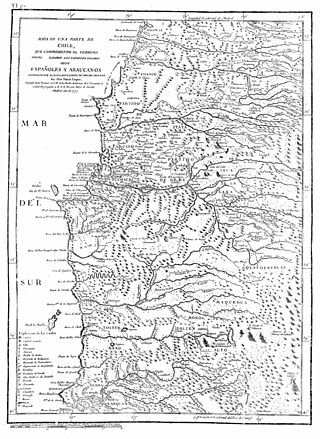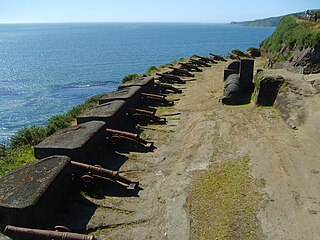Related Research Articles

Pedro Gutiérrez de Valdivia or Valdiva was a Spanish conquistador and the first royal governor of Chile. After serving with the Spanish army in Italy and Flanders, he was sent to South America in 1534, where he served as lieutenant under Francisco Pizarro in Peru, acting as his second in command.

The Arauco War was a long-running conflict between colonial Spaniards and the Mapuche people, mostly fought in the Araucanía region of Chile. The conflict began at first as a reaction to the Spanish conquerors attempting to establish cities and force Mapuches into servitude. It subsequently evolved over time into phases comprising drawn-out sieges, slave-hunting expeditions, pillaging raids, punitive expeditions, and renewed Spanish attempts to secure lost territories. Abduction of women and war rape was common on both sides.

Pedro de Villagra y Martínez was a Spanish soldier who participated in the conquest of Chile, being appointed its Royal Governor between 1563 and 1565.
Alonso García de Ramón was a Spanish soldier and twice Royal Governor of Chile: first temporarily from July 1600 to February 1601, and then from March 1605 to August 1610. He was born in Cuenca, Spain in 1552.
Alonso de Ribera y Zambrano was a Spanish soldier and twice Spanish royal governor of Chile.

The Fort System of Valdivia is a series of Spanish colonial fortifications at Corral Bay, Valdivia and Cruces River established to protect the city of Valdivia, in southern Chile. During the period of Spanish rule (1645–1820), it was one of the biggest systems of fortification in the Americas. It was also a major supply source for Spanish ships that crossed the Strait of Magellan.
Marina Ortiz de Gaete González was the wife of Pedro de Valdivia, and played an important role in the politics of the conquest and early history of the Captaincy General of Chile.

The Conquest of Chile is a period in Chilean historiography that starts with the arrival of Pedro de Valdivia to Chile in 1541 and ends with the death of Martín García Óñez de Loyola in the Battle of Curalaba in 1598, and the destruction of the Seven Cities in 1598–1604 in the Araucanía region.
Cuncos, Juncos or Cunches is a poorly known subgroup of Huilliche people native to coastal areas of southern Chile and the nearby inland. Mostly a historic term, Cuncos are chiefly known for their long-running conflict with the Spanish during the colonial era of Chilean history.
Alonso de Figueroa y Cordova was a Spanish soldier who, in the days of the reign of Philip IV of Spain, temporarily carried out the position of Captain General and Royal Governor of Chile, besides president of its Real Audiencia of Chile. His government lasted for 13 months, between April 1649 and May 1650. He was the grandfather of the Chilean historian Pedro de Cordoba y Figueroa.

In Chilean historiography, Colonial Chile is the period from 1600 to 1810, beginning with the Destruction of the Seven Cities and ending with the onset of the Chilean War of Independence. During this time, the Chilean heartland was ruled by Captaincy General of Chile. The period was characterized by a lengthy conflict between Spaniards and native Mapuches known as the Arauco War. Colonial society was divided in distinct groups including Peninsulars, Criollos, Mestizos, Indians and Black people.

The Dutch expedition to Valdivia was a naval expedition, commanded by Hendrik Brouwer, sent by the Dutch Republic in 1643 to establish a base of operations and a trading post on the southern coast of Chile. With Spain and the Dutch Republic at war, the Dutch wished to take over the ruins of the abandoned Spanish city of Valdivia. The expedition sacked the Spanish settlements of Carelmapu and Castro in the Chiloé Archipelago before sailing to Valdivia, having the initial support of the local natives. The Dutch arrived in Valdivia on 24 August 1643 and named the colony Brouwershaven after Brouwer, who had died several weeks earlier. The short-lived colony was abandoned on 28 October 1643. Nevertheless, the occupation caused great alarm among Spanish authorities. The Spanish resettled Valdivia and began the construction of an extensive network of fortifications in 1645 to prevent a similar intrusion. Although contemporaries considered the possibility of a new incursion, the expedition was the last one undertaken by the Dutch on the west coast of the Americas.
The battle of Río Bueno was fought in 1654 between the Spanish Army of Arauco and indigenous Cuncos and Huilliches of Fütawillimapu in southern Chile. The battle took place against a background of a long-running enmity between the Cuncos and Spanish, dating back to the destruction of Osorno in 1603. More immediate causes were the killing of Spanish shipwreck survivors and looting of the cargo by Cuncos, which led to Spanish desires for a punishment, combined with the prospects of lucrative slave raiding.
The Mapuche uprising of 1655 was a series of coordinated Mapuche attacks against Spanish settlements and forts in colonial Chile. It was the worst military crisis in Chile in decades, and contemporaries even considered the possibility of a civil war among the Spanish. The uprising marks the beginning of a ten-year period of warfare between the Spanish and the Mapuche.
The Salazar brothers, or more accurately siblings since they included one sister, were Spanish criollos who played important roles in mid-17th century affairs in the Captaincy General of Chile. They became infamous for their slave hunting expeditions, corruption and role in unleashing the Mapuche uprising of 1655.
In the history of colonial Chile, the Parliament of Boroa was a diplomatic meeting held on January 24, 1651, between various Mapuche groups and Spanish authorities held in the fields of Boroa. The parliament was attended by the Governor of Chile, Antonio Acuña Cabrera, who travelled to Boroa incognito from the fortress of Nacimiento in the north accompanied only by six men. This riskful crossing of Mapuche territory was considered a valiant but reckless stunt by Spanish subordinates.
Juan Moscoso was a Chilean criollo Jesuit. He was fluent in Spanish and Mapudungun. Together with fellow Jesuit Diego de Rosales Moscoso dissuaded governor Governor of Chile Antonio de Acuña Cabrera to launch new punitive expeditions against the Cunco in 1653. They argued that the murders were committed by a few Indians and warned the governor that renewing warfare would evaporate gains obtained at Boroa.
Mapuche slavery was commonplace in 17th-century Chile and a direct consequence of the Arauco War. When Spanish conquistadors initially subdued the indigenous inhabitants of Chile, there was no slavery but a form of involuntary servitude called encomienda. However, this form of forced labour was harsh and many Mapuche would end up dying in the Spanish gold mines during the 16th century.
The Huilliche uprising of 1792 was an indigenous uprising against the Spanish penetration into Futahuillimapu, territory in southern Chile that had been de facto free of Spanish rule since 1602. The first part of the conflict was a series of Huilliche attacks on Spanish settlers and the mission in the frontier next to Bueno River. Following this a militia in charge of Tomás de Figueroa departed from Valdivia ravaging Huilliche territory in a quest to subdue anti-Spanish elements in Futahuillimapu.
The 1651 wreckage of San José and the subsequent killings and looting carried out by indigenous Cuncos was a defining event in Colonial Chile that contributed to Spanish–Cunco tensions that led to the Battle of Río Bueno and the Mapuche uprising of 1655.
References
Bibliography
- Barros Arana, Diego (2000) [1884]. Historia General de Chile (in Spanish). Vol. III (2 ed.). Santiago, Chile: Editorial Universitaria. ISBN 956-11-1535-2.
- Medina, José Toribio (1906). Diccionario Biográfico Colonial de Chile (PDF) (in Spanish). Santiago, Chile: Imprenta Elzeviriana. pp. 8–9.
